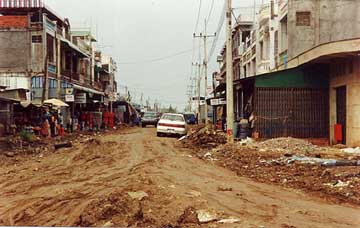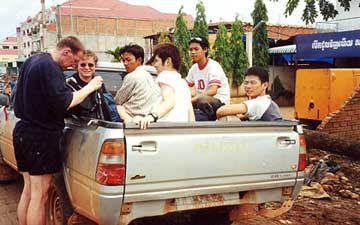To the Moon!
BANGKOK TO SIEM REAP
MARCH 18
Khao San Road never closes, so it was easy to get a 5:30 a.m. breakfast. Monks asking for alms, late-night revelers, and newly arrived backpackers were my company. I ate a fruit plate and hurried off to meet my minibus bound for the Cambodia border.
It was getting late. Just when my nerves were starting to be uncooperative, a teenaged girl showed up.
"Cambodia?" she said.
"You're not a minibus," I responded, perplexed.
"Follow me."
I followed her to Khao San Road, where she instructed me to wait some more. Taxis and tuk tuks cruised me, looking for an airport fare. With my pack and air of waiting, I was a prime candidate. I waved them off and leaned my pack against a film crew's truck. Film crews are always shooting on Khao San Road, and it's pretty much guaranteed that any foreigner who hangs around long enough will eventually get work as an extra.
The girl came back.
"Follow me," she said again.
We moved only 100 feet this time, to another film truck.
"Wait here."
A minibus pulled up and discharged Matthew, a very confused British backpacker.
"Wait here," said the girl to Matthew.
"I've been on three buses already," Matthew addressed the world in general.
A new bus pulled up and we boarded. Ruth, a 34-year-old Scottish woman, got off a different bus and boarded with us.
"Is this the right bus this time?" asked Ruth.
We all had a good laugh, drove a few blocks, and transferred six other backpackers from yet another minibus to our own. Then, another stop and two more.
Finally, we headed east in our minibus. "No Fear" was plastered across the windshield. Buddha figures on the dashboard kept us safe, while our metalhead Thai driver tried his best to challenge them.
Six hours after being told to "wait here," we arrived at the border post at Poipet. Those that had only paid their fares as far as the border were sent off to poorly negotiate their own transport to Siem Reap. The eight of us who had paid our fares all the way to Siem Reap were sent on through Cambodian Customs.

Little town across the border from Poipet
Cambodia forces new arrivals to fill out medical questionnaires. They then ask to see evidence of your good health, and sometimes even insist on evidence of the widely discredited cholera vaccination. My ducks were all in a row on my yellow WHO vaccination record, and on paper I even have the cholera vaccine, so I got through without paying a 50 baht fine. I even got an official looking piece of paper with a red stamp on it, declaring my good health to the world.
Once through Customs, we were led to a guesthouse.
"We will be on our way soon," murmured Ruth. "But first you can stop at my brother's for a drink."
We finally loaded onto the pickups for the ten-hour ride to Siem Reap. I had paid the 300 baht extra for an inside seat, so I got to cram into the double-seated air-conditioned cab along with Matthew, Ruth, Jema the Australian, and a German. Three other travelers and our luggage filled the truck bed, along with three Cambodian guys who "had a friend with a guesthouse." Matthew had the middle seat between me and the driver, and was instructed to sit with a leg on either side of the gearshift.

Our pickup
Off we went, driving about 300 meters before stopping to get a spare tire. Ten more minutes of driving, and we stopped again, this time to buy a corresponding tire rim. A minute later, we halted for a toll, and our final stop was for fuel, funneled into our tank from a giant piece of Tupperware.
The road from Poipet to Seam Reap is famous for being awful. Bayon-Pearnik, a monthly magazine out of Phnom Penh, says:
"Road has holes you can drive trucks in. Motocross track for a road, wear padded clothing and look at it like a very long fairground ride."
We spent the first three or four hours bracing ourselves for hell. It didn't come. The road was in terrible shape, but all of us had seen worse. Jema pulled out a 'Pulp Fiction' soundtrack cassette and played it in between sappy Cambodian pop songs. Now I will forever associate John Travolta's Quarter-Pounder monologue with ridiculous car trips.
Five hours in, we stopped for tasty fried rice and veggies, shuffled Ruth and Jema off to the back, and changed drivers. An hour later, we stopped to get a tire fixed, and the locals crowded around to tease Ruth and Jema. They all waved and shouted good-byes as we drove away.
Another pickup full of Cambodians and tourists overtook us. Our driver clucked at their driver's recklessness, and followed in his wake. We became a tourist parade, waving to schoolchildren as we drove past. Everyone waved back. Cambodians are outrageously friendly, and everyone always waves like they've never seen another tourist and you're the rarest, most special person in their lives.
"This is better than anywhere I've been," said Jema. I agreed. Cambodia was my first love among developing nations, although East Timor was now running neck and neck with it.
At six, someone asked the driver how much longer we had to go.
"Four," he replied without hesitation.
Shit. We'd all had a grand time bumping along the parade route, but everyone was worn out. It was too late to turn back, and making a fuss was unlikely to accomplish anything, so we all steeled our teeth and sung along to "Girl, You'll Be A Woman Soon" one more time.
The road, National Route 6 that went from the Thai border to the Vietnam border, turned into a zigzag of interconnected dirt tracks across a field.
"How does he know which one is the road?" I wondered aloud.
"I don't think he does," said Matthew. "He's just picking the best-looking one."
No one mentioned the guidebook's warnings on landmines.
On we went, and suddenly we learned what all the fuss was about. Just after dark, the road started to look like a lunar landscape. Our driver steered slowly through the craters and ridges. The road was, at least, very Khmer. The architecture of the ancient Khmer culture was all about highs and lows, ridges and valleys, as demonstrated in Angkor Wat where a moat will lead to a tower to a moat to a tower and so on.
Suddenly, there was a traffic jam. People were out of their trucks and wandering around. Some drivers were grouped together, having coffee. Our driver wound down a window and addressed another driver, who replied in Cambodian.
This wasn't a lot to go on, but it was some of the only English our driver knew. Fortunately, he had a plan. Unfortunately, the plan involved fording a muddy river and driving up the opposite bank.
Us tourists were pretty clueless as to why we plunged down the riverbank and into the mud, but when our headlights lit up the bridge we suddenly understood.
Our driver struggled to push our truck up the riverbank, and we slid back once. At least four worried tourists screamed "keep it in first," which didn't help at all as the driver couldn't understand them.
We screeched up the riverbank on the second try. No one laughed or talked for the next hour. We had all had a good laugh over the lunar landscape of a road. We had enjoyed our trek across the potential minefield and had crossed half-dozen similar bridges. The danger in the past had been from renegade Khmer Rouge elements. They were gone now, their influence having dissipated with the fracturing of the Khmer Rouge following the 1998 death of Pol Pot. We had happily traveled overland Ð it was safe now, the terrorists were gone. But of course the road was still dangerous, and the danger was physical, not political.
As we approached Siem Reap, our driver faced the added challenge of navigating through gigantic puddles of two-foot deep water. Everyone was relieved when the road became paved, and streetlights appeared (unlit, of course). We passed the Bangkok Airways office where I'd bought last year's Siem Reap-Bangkok ticket. My $100 had saved me from danger, discomfort, and fifteen hours of travel time. (I heartily recommend air travel for those wishing to go to Angkor Wat.)
The driver took us straight up Route 6, to a small turnoff, and then to the guesthouse that had been described by the passenger in the back. It's how the guesthouses of Siem Reap drum up business Ð they pay drivers to drop truckloads of exhausted tourists at their doorsteps.
The guesthouse looked all right, but I didn't appreciate being railroaded, and had booked myself into the "European Guesthouse" based on its attractive website. When I walked up, four Cambodian women sprang into action, ushering me into a huge five-dollar room. The bathrooms were down the hall, but there was only one other guest. I got ready to walk to the nearby Bayon restaurant — and then the rain started. I went to bed hungry. I needed the sleep more than the food anyway.


